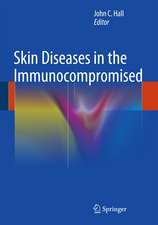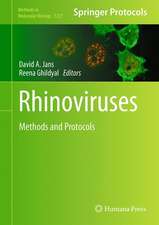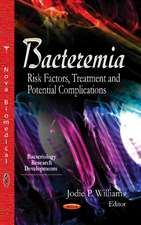Virology II
en Limba Engleză Paperback
Chapter 1 highlights seminal findings from the basic sciences and describes the benefits and risks of current medications based on the recent advances in genetics, immunology, diagnostic imaging, medicinal chemistry, clinical therapeutics and health-care systems.
Chapter 2 presents a brief description of foot-and-mouth disease virus (FMDV) and the different functions of various viral proteins.
Chapter 3 proposes a model, in which humoral immunity against monomer capsid protein (CP) is immunopathogenic; whereas antibodies generated in response to the intact virion results in protective immunity.
Chapter 4 discusses current understandings of human innate immune responses to respiratory viral infections in the airways, viral evasion strategies, and abnormalities in the immune responses in people with chronic airways diseases, leading to increased susceptibility and worsened outcome.
Chapter 5 presents three replication modes: normal, rolling circle, and double rolling circle replication (DRCR).
Chapter 6 considers the evidence for transmission of the flavivirus West Nile Virus (WNV) by ticks in addition to the major transmission vector, mosquitoes.
Chapter 7 describes two tick-borne viruses that may be circulating in the Iberian Peninsula: the Crimean-Congo Hemorrhagic Fever Virus (CCHFV) and the European Tick-Borne Encephalitis Virus (TBEV).
Chapter 8 reviews the evidences supporting the contribution of miRNA regulation to Retinoic Acid (RA)-induced differentiation of neuroblastoma cells.
Chapter 9 summarizes recent findings shedding light on how multiple geminiviral proteins interact with post-translational modification pathways, and how these interactions impact pathogenicity.
Chapter 10 summarizes the structure and function of immunoregulatory molecule CD150 (SLAM), known also as a receptor of an important human pathogen, measles virus.
Chapter 11 attempts to develop an "E.coli" expression and purification system that utilises the insoluble nature of inclusion bodies to produce soluble and endotoxin-free Bovine Viral Diarrhoea Virus (BVDV) E2 protein suitable for "in vivo" applications.
Chapter 12 reviews how adenovirus alternative splicing is regulated during a lytic virus infection. Special emphasis is devoted to the significance of cellular protein kinases, phosphatases and SR proteins on the function of the adenovirus L4-33K alternative splicing factor.
Chapter 13 provides an overview of the potential of resistance development to influenza antivirals in the enivironment due to the discharge of pharmaceutical residues.
Chapter 14 describes the chronic phase of a disease called Chikungunya in a cohort of affected patients.
Chapter 15 reviews the incidence of Mokola virus, an unusual member of the Lyssavirus genus in southern Africa and the subsequent antigenic and genetic studies thereof.
Chapter 16 presents a review on the advances made so far in search of novel drug targets against the HCV (Hepatitis C virus)-encoded non-structural protein, NS3.
Chapter 17 reviews, the potential role of eltrombopag in the context of hepatitis C virus (HCV)-related thrombocytopenia.
Preț: 575.48 lei
Preț vechi: 605.78 lei
-5% Nou
Puncte Express: 863
Preț estimativ în valută:
110.13€ • 114.28$ • 92.05£
110.13€ • 114.28$ • 92.05£
Tipărit la comandă
Livrare economică 17-31 martie
Preluare comenzi: 021 569.72.76
Specificații
ISBN-13: 9781922227454
ISBN-10: 1922227455
Pagini: 392
Dimensiuni: 203 x 254 x 26 mm
Greutate: 0.78 kg
Editura: Iconcept Press
ISBN-10: 1922227455
Pagini: 392
Dimensiuni: 203 x 254 x 26 mm
Greutate: 0.78 kg
Editura: Iconcept Press























